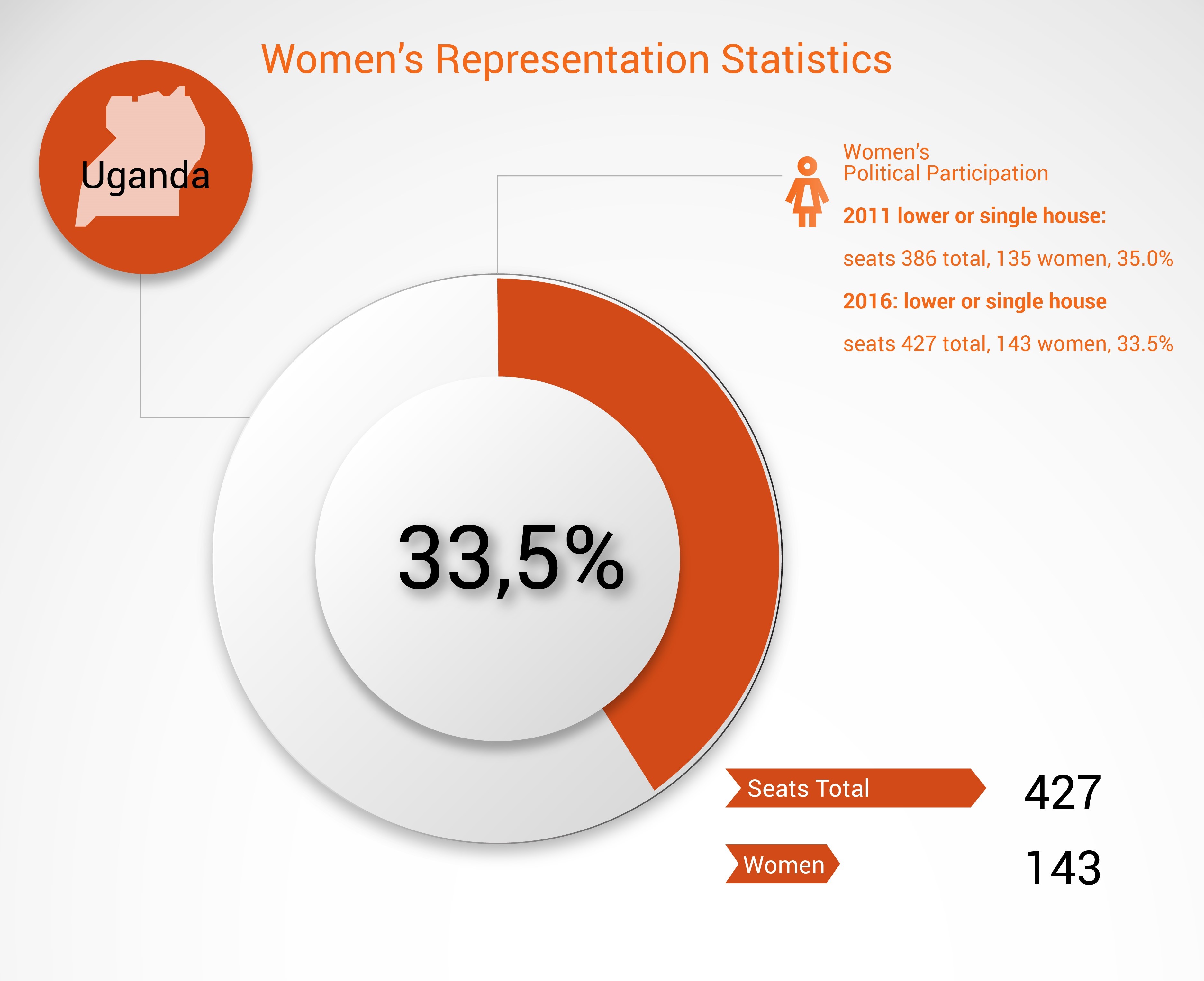2016 Elections Monitoring
Ugandan Presidential Elections were held on the 18th February 2016.
President Yoweri Museveni of the National Resistance Movement (NRM) has been in power for 30 years and was standing for his fifth consecutive term. He faced 7 candidates including the main opposition leader Kizza Besigye, from the Forum for Democratic Change (FDC); Amama Mbabazi, a former Prime Minister, an independent candidate with the backing of the Democratic Alliance (TDA)/ Go Forward. Of the 8 candidates who ran, Maureen Kyalya was the only woman. 9, 851,812 votes were cast, and Yoweri Museveni won with 61% of the vote compared to Besigye’s 36%. Kyalya received only 0.43%. It should be added that the election was not without controversy. Many claimed that rigging and violence at polling stations was rife and opposition candidates were of the view that the election outcome was the result of widespread fraud, propaganda, and the repeated arrest of opposition members.
Uganda is a presidential republic - the President of Uganda is both Head of State and Head of Government. As Head of State, the President has executive power and is elected for a five-year term. In Uganda, there is a multi-party system, and its unicameral Parliament is the country’s legislative body. The 2016 Presidential Elections were the third elections held under the multi-party system. Members of Parliament are elected by the first-past-the-post system, but there are legislated quotas in relation to women both for the single/lower house of Parliament and at the sub-national level. As Head of State, the President has executive power and is elected for a five-year term. The elections used the two-round system, whereby candidates needed to receive at least 50% of the vote to be elected in the first round.The legal framework consists of the Constitution, Electoral Commission Act (ECA), Presidential Election Act (PEA), Parliamentary Election Act (PPEA). Under Article 78(1) of the Constitution, the parliament must consist of 1 female representative for all 112 districts in Uganda. Furthermore, under Article 8 of the Parliamentary Elections Act 2005, of the 10 representatives of the Uganda People’s Defence Forces, 2 must be women; of the 5 youth representatives, 1 must be a woman; of the 5 representatives of persons with disabilities, 1 must be a woman; and of the 5 representatives of workers, 1 must be a woman.
Women’s Political Participation
Generally, female political participation has been rising since the 2006 elections. The number of women occupying seats in Parliament has increased from 99 in 2006, to 131 in 2011, to 143 in 2016. Women now hold 31% of the seats in Parliament. In the 2011 elections, there was also only 1 female presidential candidate, Beti Olive Kamya Namisango Turwomwe, however, she only received a tiny 0.66% of the vote. During the 2016 elections there was only one female in the presidential race, Mayreen Kyalya. Kyalya regarded herself as an activist for social change and is a lawyer who studied at the University of Portsmouth in the UK. Her viewpoint was that even with challenges for democracy in Uganda, she could provide solutions and change, as a skilled woman. “There is lots of tear gas in every police station but there is no medicine in the hospitals. Trust me, I am a mother. I will heal to this country with love”.
The amended Presidential Election Act has been found to downplay women’s participation in elections. It increased the nomination fees for presidential candidates from 8 million to 20 million Uganda shillings, and removed the provision for a vehicle and the contribution of 20 million Uganda shillings to the candidates’ campaigns.Such changes have dramatically reduced and rendered inadequate the resources of female candidates. It has also been found that women continue to struggle with structural, socio-economic and political constraints that undermine their political participation. Issues of poverty, lack of education, insufficient access to information and political parties’ reluctance to place women in leadership positions, remain key hindrances to political and leadership equality. Furthermore, the level of violence surrounding elections in Uganda continues to cause problems for women’s participation.
In Uganda statutory law is applied alongside customary and religious laws. While the Constitution of 1995 provides for equal rights between men and women (article 33) and holds laws and customs that violate the constitutional guarantees on equality to be void (Article 33(6)); discriminatory statutory, customary and religious laws remain in force. Although several laws have recently been enacted to improve the situation of women, their implementation is hindered by traditions and deeply entrenched patriarchal attitudes, especially in rural areas. Years of armed conflict in the northern parts of the country have also contributed to massive violations of women’s human rights.
Conclusion
More needs to be done to enhance female participation in politics in Uganda. A recent poll found that a staggering 74% of male respondents and 69% of female respondents felt that Uganda was not ready for a female President. If women are to have a real chance, changes must be made to deep-rooted societal views, resources, and the level of violence.

